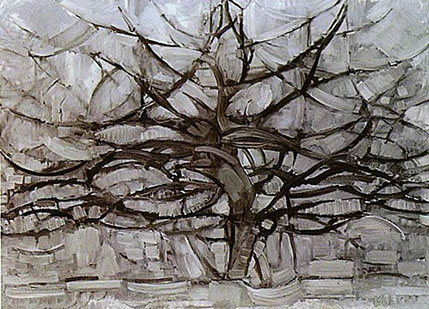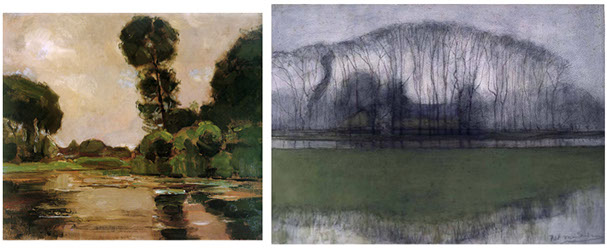Gerwald Radsma
Statements
Mondriaans travels.
As Mondriaan departed reality, he ventured into a familiar world, a mirrored, blurred and faded world, sometimes lifeless grey, sometimes super saturated. In this phase of departure between 1907 and 1912, he did not yet let the reality go and did not yet slip into his mathematical nirvana. Step by step, slowly immersing himself into this other world. How much can he let go of this world? In what world will he end up? This was not known for him at the time off of his serach of course. A clear path can be made in hindsight, but not at the phase of creation. It took him five years.
The position of a Photoshop artist.
Image manipulation is an image altering activity. In order to alter an image you must first take an image, or find an image. Unlike a painter who can construct a completely new reality. The digital artist finds herself boxed in between the naked reality of photography and the complete freedom of the painter. To manipulate an image is to change, and alter the image; And so to change and alter the reality. As you begin with a photograph and not by painting you do not to construct the entire image from scratch, and you do not place every brush stroke, but you inherent some of the qualities of the photograph. And by not keeping the photo as it is, is not leaving reality as it is. So, being a child of both painting and photography, you inherent complete freedom and pure realism. And leaves you with the questions what and why? The reality is perfect as it is, you don`t have to create it from scratch. So what do you alter and why do you want to alter it?
As like Mondriaan, I find myself departing this world, but chasing it's echoes, reflection, memories and feelings. But unlike Mondriaan I dare not go over the threshold to a complete altered reality. My focus lies between the inner and the outer world, because they leak into each other. On the border of both worlds the thruth is running both ways.
I am filtering this reality for elements, to see if I can find the glimps of a world beyond this one. If you strip all the distractions of an object, for instance, a flower, and you take a deep look at it, and at the same time observe it with your minds eye, you can almost perceive the timeless shape of an object, which is stored in the sub conscience. This timeless form is an element of the emotional landscape, it is the language of thoughts, dreams and memories, or experiences (qualia). This is not the real object, nor is it a sublime object, like Plato`s universals. It is a simplified and reduced symbol. In order for the brain to process thoughts, it has to boil reality down to its essentials, for it to function as a language.
This is the language of art.
As with the function of language, art can function to distribute data from one mind tot the other. But without communicating with language. Because art consist of these timeless symbols, contrived of a reduced reality. It can communicate feelings and emotion, perhaps meaning, without talking about them. The reduction process is a private and enclosed process, so private, one cannot really see her own symbols. It is an aspect of the data collecting and pattern recognising functions of the sub conscience (Dual process theory, Unconscious thought theory). All this happens behind closed doors, through practice in mediation, mindfullness, and visualisation, one can only perceive glimpse of them. So unlike the symbols language uses, these symbols are not part of a standardized system. The tree in your mind is not the same as in mine, or in Mondriaan's mind (Concept). And above that, you have no direct access to the entire catalogue of your minds images. Maybe this is for the better, to keep us sane.
This is the main reason why art is so subjective. The experiences in your life will shape the symbols in your sub conscience, and so does mine.
But because some of the experience (qualia) we have are shared, as with seeing the grey tree on Mondriaans Canvas, we can share the same symbols, or better, roughly the same. Still they are slightly altered, because these symbols and feelings interlock in a fuzzy system of associations. We can both have the same image in our mind, but still can have different emotions and meaning attached to it.
Since we have a lot of these shared experiences, that are all added up to our list of symbols, you can almost speak of a language. Art made by, for instance, a sculptor can refer, not intentionally to an imprinted image, for instance the Mother Mary. Me, on my turn, carry another instance of this this symbol in my mind, and I will react to this image from the same sub conscience symbol, also not intentionally. We share the same link but none of us are aware of this.
There is some thoughts that some of these symbols can even be past down by genes. Beautiful fertile women are a popular subject for male artist. And a valley which has a nice little stream, where you can get lots of food, and you can see enemies or predators from far away, is a sound commercial choice. Images like these seem imprinted in the mind. We react to certain scene's because it is beneficial for us in an evolutionary way. These are the symbols I am exploring.



Piet Mondriaan 1872 - 1944


Isolated tree on the Gein, 1907 (location unknown)
The Geinrust farm, 1905 (Frans Hals museum, Haarlem)
Isolated tree on the Gein, c. 1906 (Gemeentemuseum, The Hague)
The Geinrust farm in the fog, 1907 (Gemeentemuseum, The Hague)
Trees along the Gein, 1907-1908 (Gemeentemuseum, The Hague)
Peupliers rouges au couchant, 1908 (private collection)
Night : the red tree, 1908-1910 (Gemeentemuseum, The Hague)
Study for Tree 1 – Tableau 2 – Composition VII, 1912 (Gemeentemuseum, The Hague)
Study for Tree 2 – Composition VII, 1913 (Gemeentemuseum, The Hague)
Study for the blue apple tree, 1908 (location unknown)
The blue apple tree, 1908 (Gemeentemuseum, The Hague)
Apple tree, pointillist version, 1908-1909 (Museum of Fine Arts, Dallas)
Study for the grey tree, 1911 (Gemeentemuseum, The Hague)
The grey tree, 1911 (Gemeentemuseum, The Hague)
Apple blossoms, 1912 (Gemeentemuseum, The Hague)
Pier and Ocean (Composition No.10), 1915 (Kröller-Müller, Otterlo)






.jpg?crc=3781519534)

Black on Maroon 1958, Tate Modern, London
No. 61 (Rust and Blue), 1953, Museum of Contemporary Art, Los Angeles
No. 14 (1960), SFMOMA, San Fransico
Black in Deep Red, 1957, Private Collection
<
>
Mark Rothko 1903 - 1970














%2c_oil_on_canvas%2c_70_x_99_cm%2c_gemeentemuseum_den_haag2.jpg?crc=177325351)
%2c_oil_on_canvas%2c_797_x_1091_cm%2c_gemeentemuseum_den_haag%2c_netherlands.jpg?crc=336483312)












%2c_oil_on_canvas%2c_70_x_99_cm%2c_gemeentemuseum_den_haag285x201.jpg?crc=503742006)
%2c_oil_on_canvas%2c_797_x_1091_cm%2c_gemeentemuseum_den_haag%2c_netherlands278x201.jpg?crc=4274022513)
